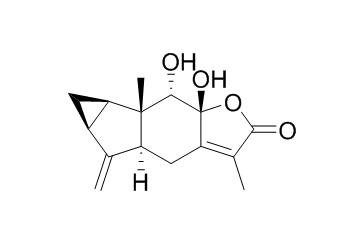Chloranthalactone E
Chloranthalactone E is a natural product from Chloranthus serratus.
Inquire / Order:
manager@chemfaces.com
Technical Inquiries:
service@chemfaces.com
Tel:
+86-27-84237783
Fax:
+86-27-84254680
Address:
1 Building, No. 83, CheCheng Rd., Wuhan Economic and Technological Development Zone, Wuhan, Hubei 430056, PRC
Providing storage is as stated on the product vial and the vial is kept tightly sealed, the product can be stored for up to
24 months(2-8C).
Wherever possible, you should prepare and use solutions on the same day. However, if you need to make up stock solutions in advance, we recommend that you store the solution as aliquots in tightly sealed vials at -20C. Generally, these will be useable for up to two weeks. Before use, and prior to opening the vial we recommend that you allow your product to equilibrate to room temperature for at least 1 hour.
Need more advice on solubility, usage and handling? Please email to: service@chemfaces.com
The packaging of the product may have turned upside down during transportation, resulting in the natural compounds adhering to the neck or cap of the vial. take the vial out of its packaging and gently shake to let the compounds fall to the bottom of the vial. for liquid products, centrifuge at 200-500 RPM to gather the liquid at the bottom of the vial. try to avoid loss or contamination during handling.
Neurochem Int.2018, 121:114-124
University of Guelph2021, 12.
J Pharm Biomed Anal.2024, 241:115990.
Naunyn Schmiedebergs Arch Pharmacol.2021, 394(1):107-115.
Revista Brasileira de Farmacognosia2024, 34:1091-1100.
Nutrients.2021, 13(1):254.
Front Pharmacol.2018, 9:756
Vietnam Journal of Food Control2022, 5(3):pp.390-401.
Plant Cell Physiol.2023, 64(7):716-728.
Biomedicines.2024, 12(12):2928.
Related and Featured Products
Phytomedicine. 2018 Oct 1;49:23-31
In vitro inhibitory properties of sesquiterpenes from Chloranthus serratus on cell motility via down-regulation of LIMK1 activation in human breast cancer[Pubmed:
30217259]
Three sesquiterpenes, Chloranthalactone E (compound 1), serralactone A (compound 2, SERA is used in the further testing), and 8β, 9α-dihydroxylindan-4(5), 7(11)-dien-8α, 12-olide (compound 3) were isolated from Chloranthus serratus, and the anti-LIMK1 activities of these compounds were investigated by kinase-Glo® luminescent kinase assay.
Zhong Yao Cai. 2015 Oct;38(10):2087-90.
Sesquiterpenes of Chloranthus serratus Root.[Pubmed:
27254920]
To study sesquiterpenes from the root of Chloranthus serratus.
METHODS AND RESULTS:
The sesquiterpenes of Chloranthus serratus were isolated and purified by various chromatographic techniques, such as silica gel, Sephadex LH-20 and preparative HPLC. The structures of these isolated compounds were identified by spectroscopic analysis. Ten sesquiterpenes were isolated and identified as follows: 1β, 8β-dihydroxy-eudesman-4 (15), 7 (11) -dien-8α, 12-olide (I), curcolonol (II), 4β, 8β-dihydroxy-5α (H) -eudesm-7 (11) -en-8, 12-olide (III), 1β, 8,β-dihydroxy-eudesman-3, 7 (11) -dien-8α, 12-olide (IV), multistalactone E (V), zedoarofuran (VI), 8β,9α-dihydroxylindan-4(5), 7(11) -dien-8α,12-olide(VII), serralactone A (VIII), 8-epi-ivangustin (IX), and Chloranthalactone E (X ).
CONCLUSIONS:
Compounds I, II, IV - VII, IX and X are isolated from Chloranthus serratus for the first time.



